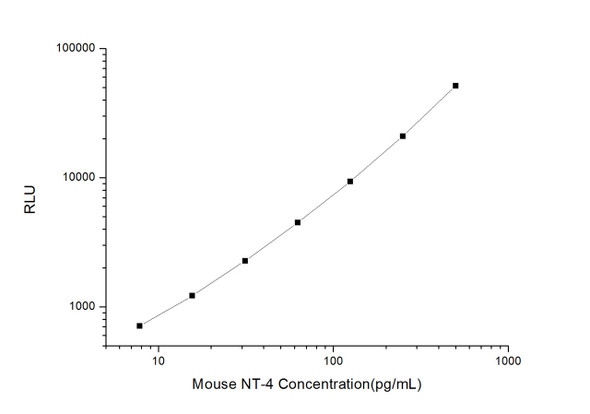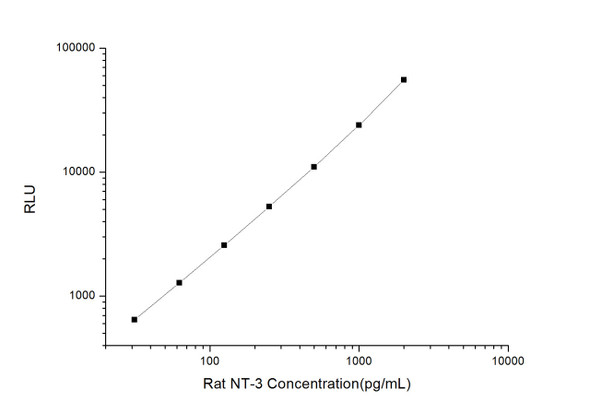Human Cell Biology ELISA Kits 5
Human NT-4 (Neurotrophin 4) CLIA Kit (HUES01046)
- SKU:
- HUES01046
- Product Type:
- ELISA Kit
- ELISA Type:
- CLIA Kit
- Size:
- 96 Assays
- Sensitivity:
- 18.75pg/mL
- Range:
- 31.25-2000pg/mL
- ELISA Type:
- Sandwich
- Reactivity:
- Human
- Sample Type:
- Serum, plasma and other biological fluids
- Research Area:
- Cell Biology
Description
| Assay type: | Sandwich |
| Format: | 96T |
| Assay time: | 4.5h |
| Reactivity: | Human |
| Detection method: | Chemiluminescence |
| Detection range: | 31.25-2000 pg/mL |
| Sensitivity: | 18.75 pg/mL |
| Sample volume: | 100µL |
| Sample type: | Serum, plasma and other biological fluids |
| Repeatability: | CV < 15% |
| Specificity: | This kit recognizes Human NT-4 in samples. No significant cross-reactivity or interference between Human NT-4 and analogues was observed. |
This kit uses Sandwich-CLIA as the method. The micro CLIA plate provided in this kit has been pre-coated with an antibody specific to Human NT-4. Standards or samples are added to the appropriate micro CLIA plate wells and combined with the specific antibody. Then a biotinylated detection antibody specific for Human NT-4 and Avidin-Horseradish Peroxidase (HRP) conjugate are added to each micro plate well successively and incubated. Free components are washed away. The substrate solution is added to each well. Only those wells that contain Human NT-4, biotinylated detection antibody and Avidin-HRP conjugate will appear fluorescence. The Relative light unit (RLU) value is measured spectrophotometrically by the Chemiluminescence immunoassay analyzer. The RLU value is positively associated with the concentration of Human NT-4. The concentration of Human NT-4 in the samples can be calculated by comparing the RLU of the samples to the standard curve.
| UniProt Protein Function: | NT-4/5: Target-derived survival factor for peripheral sensory sympathetic neurons. Defects in NTF4 may be associated with susceptibility to primary open angle glaucoma type 1O (GLC1O). A form of primary open angle glaucoma (POAG). POAG is characterized by a specific pattern of optic nerve and visual field defects. The angle of the anterior chamber of the eye is open, and usually the intraocular pressure is increased. The disease is asymptomatic until the late stages, by which time significant and irreversible optic nerve damage has already taken place. Belongs to the NGF-beta family. |
| UniProt Protein Details: | Protein type:Cytokine; Secreted; Cell development/differentiation; Secreted, signal peptide Chromosomal Location of Human Ortholog: 19q13. 3 Cellular Component: endoplasmic reticulum lumen; cytoplasmic membrane-bound vesicle; extracellular region Molecular Function:neurotrophin p75 receptor binding; growth factor activity Biological Process: mechanoreceptor differentiation; epidermis development; cell-cell signaling; long-term memory; regulation of neuron differentiation; adult locomotory behavior; sensory organ boundary specification; ganglion mother cell fate determination; negative regulation of neuron apoptosis; transmembrane receptor protein tyrosine kinase signaling pathway; neurite morphogenesis Disease: Glaucoma 1, Open Angle, O |
| NCBI Summary: | This gene is a member of a family of neurotrophic factors, neurotrophins, that control survival and differentiation of mammalian neurons. The expression of this gene is ubiquitous and less influenced by environmental signals. While knock-outs of other neurotrophins including nerve growth factor, brain-derived neurotrophic factor, and neurotrophin 3 prove lethal during early postnatal development, NTF5-deficient mice only show minor cellular deficits and develop normally to adulthood. [provided by RefSeq, Jul 2008] |
| UniProt Code: | P34130 |
| NCBI GenInfo Identifier: | 462741 |
| NCBI Gene ID: | 4909 |
| NCBI Accession: | P34130. 1 |
| UniProt Secondary Accession: | P34130,Q6FH56, |
| UniProt Related Accession: | P34130,AAB20549 |
| Molecular Weight: | 210 |
| NCBI Full Name: | Neurotrophin-4 |
| NCBI Synonym Full Names: | neurotrophin 4 |
| NCBI Official Symbol: | NTF4 |
| NCBI Official Synonym Symbols: | NT4; NT5; NT-4; NT-5; NTF5; GLC10; GLC1O; NT-4/5 |
| NCBI Protein Information: | neurotrophin-4; neurotrophin-5; neutrophic factor 4; neurotrophic factor 4; neurotrophic factor 5; neurotrophin 5 (neurotrophin 4/5) |
| UniProt Protein Name: | Neurotrophin-4 |
| UniProt Synonym Protein Names: | Neurotrophin-5; NT-5; Neutrophic factor 4 |
| Protein Family: | Neurotrophin |
| UniProt Gene Name: | NTF4 |
| UniProt Entry Name: | NTF4_HUMAN |
As the RLU values of the standard curve may vary according to the conditions of the actual assay performance (e. g. operator, pipetting technique, washing technique or temperature effects), the operator should establish a standard curve for each test. Typical standard curve and data is provided below for reference only.
| Concentration (pg/mL) | RLU | Average | Corrected |
| 2000 | 52172 59270 | 55721 | 55693 |
| 1000 | 22205 25743 | 23974 | 23946 |
| 500 | 11329 10735 | 11032 | 11004 |
| 250 | 4928 5660 | 5294 | 5266 |
| 125 | 2747 2469 | 2608 | 2580 |
| 62.5 | 1398 1224 | 1311 | 1283 |
| 31.25 | 633 715 | 674 | 646 |
| 0 | 28 28 | 28 | -- |
Precision
Intra-assay Precision (Precision within an assay): 3 samples with low, mid range and high level Human NT-4 were tested 20 times on one plate, respectively.
Inter-assay Precision (Precision between assays): 3 samples with low, mid range and high level Human NT-4 were tested on 3 different plates, 20 replicates in each plate.
| Intra-assay Precision | Inter-assay Precision | |||||
| Sample | 1 | 2 | 3 | 1 | 2 | 3 |
| n | 20 | 20 | 20 | 20 | 20 | 20 |
| Mean (pg/mL) | 105.60 | 267.46 | 841.29 | 115.36 | 251.07 | 925.33 |
| Standard deviation | 9.22 | 24.50 | 67.64 | 11.95 | 29.00 | 70.60 |
| C V (%) | 8.73 | 9.16 | 8.04 | 10.36 | 11.55 | 7.63 |
Recovery
The recovery of Human NT-4 spiked at three different levels in samples throughout the range of the assay was evaluated in various matrices.
| Sample Type | Range (%) | Average Recovery (%) |
| Serum (n=5) | 97-109 | 104 |
| EDTA plasma (n=5) | 99-117 | 106 |
| Cell culture media (n=5) | 85-99 | 92 |
Linearity
Samples were spiked with high concentrations of Human NT-4 and diluted with Reference Standard & Sample Diluent to produce samples with values within the range of the assay.
| Serum (n=5) | EDTA plasma (n=5) | Cell culture media (n=5) | ||
| 1:2 | Range (%) | 91-104 | 100-115 | 84-99 |
| Average (%) | 96 | 107 | 91 | |
| 1:4 | Range (%) | 88-101 | 95-109 | 99-114 |
| Average (%) | 93 | 102 | 106 | |
| 1:8 | Range (%) | 103-115 | 95-113 | 91-104 |
| Average (%) | 109 | 103 | 98 | |
| 1:16 | Range (%) | 92-106 | 93-107 | 100-114 |
| Average (%) | 97 | 98 | 106 |
An unopened kit can be stored at 4°C for 1 month. If the kit is not used within 1 month, store the items separately according to the following conditions once the kit is received.
| Item | Specifications | Storage |
| Micro CLIA Plate(Dismountable) | 8 wells ×12 strips | -20°C, 6 months |
| Reference Standard | 2 vials | |
| Concentrated Biotinylated Detection Ab (100×) | 1 vial, 120 µL | |
| Concentrated HRP Conjugate (100×) | 1 vial, 120 µL | -20°C(shading light), 6 months |
| Reference Standard & Sample Diluent | 1 vial, 20 mL | 4°C, 6 months |
| Biotinylated Detection Ab Diluent | 1 vial, 14 mL | |
| HRP Conjugate Diluent | 1 vial, 14 mL | |
| Concentrated Wash Buffer (25×) | 1 vial, 30 mL | |
| Substrate Reagent A | 1 vial, 5 mL | 4°C (shading light) |
| Substrate Reagent B | 1 vial, 5 mL | 4°C (shading light) |
| Plate Sealer | 5 pieces | |
| Product Description | 1 copy | |
| Certificate of Analysis | 1 copy |
- Set standard, test sample and control (zero) wells on the pre-coated plate and record theirpositions. It is recommended to measure each standard and sample in duplicate. Note: addall solutions to the bottom of the plate wells while avoiding contact with the well walls. Ensuresolutions do not foam when adding to the wells.
- Aliquot 100 µL of standard solutions into the standard wells.
- Add 100 µL of Sample / Standard dilution buffer into the control (zero) well.
- Add 100 µL of properly diluted sample (serum, plasma, tissue homogenates and otherbiological fluids. ) into test sample wells.
- Cover the plate with the sealer provided in the kit and incubate for 90 min at 37 °C.
- Aspirate the liquid from each well, do not wash. Immediately add 100 µL of BiotinylatedDetection Ab working solution to each well. Cover the plate with a plate seal and gently mix. Incubate for 1 hour at 37 °C.
- Aspirate or decant the solution from the plate and add 350 µL of wash buffer to each welland incubate for 1-2 minutes at room temperature. Aspirate the solution from each well andclap the plate on absorbent filter paper to dry. Repeat this process 3 times. Note: a microplatewasher can be used in this step and other wash steps.
- Add 100 µL of HRP Conjugate working solution to each well. Cover with a plate seal andincubate for 30 min at 37 °C.
- Aspirate or decant the solution from each well. Repeat the wash process for five times asconducted in step 7.
- Add 100 µL of Substrate mixture solution to each well. Cover with a new plate seal andincubate for no more than 5 min at 37 °C. Protect the plate from light.
- Determine the RLU value of each well immediately.






